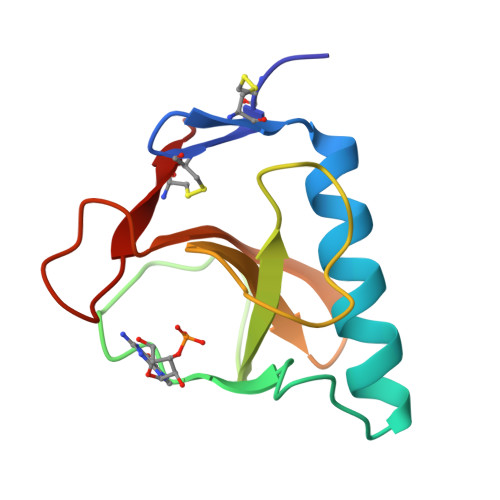Crystal structure of ribonuclease Ms (as a ribonuclease T1 homologue) complexed with a guanylyl-3',5'-cytidine analogue.
Nonaka, T., Nakamura, K.T., Uesugi, S., Ikehara, M., Irie, M., Mitsui, Y.(1993) Biochemistry 32: 11825-11837
- PubMed: 8218254
- DOI: https://doi.org/10.1021/bi00095a011
- Primary Citation of Related Structures:
1RDS, 1RMS - PubMed Abstract:
A ribonuclease T1 homologue, ribonuclease Ms (RNase Ms) from Aspergillus saitoi, has been crystallized as a complex with a substrate analogue GfpC where the 2'-hydroxyl (2'-OH) group of guanosine in guanylyl-3',5'-cytidine (GpC) is replaced by the 2'-fluorine (2'-F) atom to prevent transesterification. The crystal structure of the complex was solved at 1.8-A resolution to a final R-factor of 0.204. The role of His92 (RNase T1 numbering) as the general acid catalyst was confirmed. Of the two alternative candidates for a general base to abstract a proton from the 2'-OH group, His40 and Glu58 were found close to the 2'-F atom, making the decision between the two groups difficult. We then superposed the active site of the RNase Ms/GfpC complex with that of pancreatic ribonuclease S (RNase S) complexed with a substrate analogue UpcA, a phosphonate analogue of uridylyl-3',5'-adenosine (UpA), and found that His12 and His119 of RNase A almost exactly coincided with Glu58 and His92, respectively, of RNase Ms. Similar superposition with a prokaryotic microbial ribonuclease, RNase St [Nakamura, K. T., Iwahashi, K., Yamamoto, Y., Iitaka, Y., Yoshida, N., & Mitsui, Y. (1982) Nature 299, 564-566], also indicated Glu58 as a general base. Thus the present comparative geometrical studies consistently favor, albeit indirectly, the traditional as well as the most recent notion [Steyaert, J., Hallenga, K., Wyns, L., & Stanssens, P. (1990) Biochemistry 29, 9064-9072] that Glu58, rather than His40, must be the general base catalyst in the intact enzymes of the RNase T1 family.
Organizational Affiliation:
Department of BioEngineering, Nagaoka University of Technology, Japan.



















